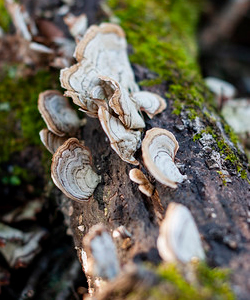Mushrooms and Other Fascinating Fungi

During Florida’s rainy season, fungi flourish. Toadstools, fairy-rings, puffballs and a hundred other alien shapes appear in the landscape, seemingly overnight.
The fungal kingdom presents an impressive variety of forms and functions, and inspires an equally impressive list of questions. In this article we’ll introduce you to the world of mycology (the study of fungal lifeforms) and provide answers to the most common inquiries. Perhaps most importantly, we’ll also help connect you with UF/IFAS Extension experts who can help you address problems specific to your home and landscape. Read on for help in identifying, removing, and even cultivating fungi.
Q: What are fungi?
Answer: Yeast, toadstools, mold, mildew, mushrooms, and truffles are all fungi. They are not plants and do not photosynthesize. Genetically they actually have more in common with Kingdom Animalia, but they aren’t animals either.
Fungi are a unique kingdom of organisms. They are heterotrophic, meaning their source of carbon nourishment comes from other living (or once living) organisms. In the case of fungi, this usually means they feed on decaying organic matter, like rotting wood. Some are also pathogens, attacking plants, people, and other organisms. Others are mutualists, living in mutually-beneficial relationships with other organisms, particularly plants. Fungi can be single or multicellular; microscopic or miles wide; helpful, harmful, neither, or both. The biodiversity of the fungal world is enormous.
Q: Why do fungi appear so suddenly?

Answer: Although fungi can be found in some of the most extreme environments on Earth, the species we encounter thrive in moist, warm environments. They can survive for years in the soil, unseen, until the favorable conditions of Florida’s rainy season trigger a surge of growth and reproductive activity. In this case the “mushrooms” you see popping up in your yard are actually the reproductive structures of the larger underground organism. The spores are released above ground to float or swim away from the parent.
Q: What kind of fungus is this?
Answer: Identification is important regardless of whether you’re controlling or cultivating fungi in your landscape. You could pursue a degree in mycology but as a less arduous alternative, you can also reach out to the experts at UF/IFAS. We are here to help.
For assistance identifying a fungus, call the Extension agents at your county Extension office. The department of plant pathology also has fungal identification services and helpful online resources. Please give these Extension experts a call and they’ll be happy to help you identify any mystery fungi.
Q: How do I get rid of a fungus?

Answer: A better question might be, “Do I need to get rid of fungi?” Though some find them unsightly, mushrooms rarely damage turfgrass. Instead they perform a valuable service by breaking down rotting organic matter in the landscape, enriching the soil wherever they grow. Still, if a fungus is growing in an inappropriate location or known to be toxic, removal may be necessary.
The first step in any Integrated Pest Management plan is to avoid problems through early detection and cultural practices. Fungi thrive in moist environments; if an excess of moisture in your landscape is the fault of an over-active irrigation system, it may be time to recalibrate.
If changing cultural practices doesn’t eliminate the problem, chemical treatments are available. Fungicides are pesticides that act directly on fungi. Give your county Extension office or the Pesticide Information Office a call for help choosing the most appropriate option for your specific fungal issue.
Q: How can I grow fungi?

Answer: We’re glad you asked! Fungi are easy to grow and delicious additions to a kitchen garden. Gardening Solutions and the Electronic Data Information Source of UF/IFAS Extension (EDIS) have a wealth of resources to help you grow mushrooms at home. See the links at the bottom of this article for more resources.
Oyster, shitake, paddy straw, and huitlacoche mushrooms are just a few of the edible species that can be cultivated in Florida. Wild mushrooms are not on the menu, however. Some species of fungi are toxic and a few are “look-a-likes,” mimicking the form of an edible variety. Unless you are absolutely sure it has been correctly identified as edible, experts urge you to not eat mushrooms found in the wild.
If you have questions about adding fungi to or removing from your landscape, please contact your county Extension office.
Fungi to add to the garden – EDIS
- D.I.Y. FunGuide: Grow Your Own Oyster Mushrooms at Home
- Isolation of Mother Cultures and Preparation of Spawn for Oyster Mushroom Cultivation
- The Pecan Truffle (Tuber lyonii): A Gourmet Truffle Native to the Southeastern US
